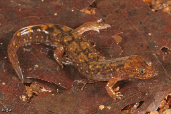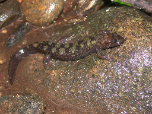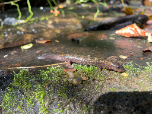Southern Shovel-Nosed Dusky Salamander (D. aureatus)
Description: Also called the Golden Shovel-nosed Salamander. Being entirely aquatic, they have an extremely keeled tail and dark toe tips. Their snout begins to angle downward behind the eyes and the eyes are more sunken in, giving them a squinty appearance. The ventral coloration is pale with a mottled gray wash and dorsal patterning is opposite or alternating spotting or blotches.
Habitat: They are closely related to Black-bellied Salamanders and have sometimes been considered an ecotype of the species before modern genomics. Their habitat is similar as well, inhabiting second to third order rocky streams at mid to low elevation. However, they are an entirely aquatic species that lives in the riffles in the middle of the stream.
Range: Southern Shovelnose Salamanders are found mainly in North Georgia and extreme Northwest South Carolina in river drainages that lead to either the Gulf of Mexico or Atlantic Ocean.
Found in these States:
GA
Diet: Mainly consists of larval or nymphal stages of aquatic insects, particularly mayfly and caddis fly larvae.
Reproduction: Females deposit 20 to 65 eggs in spring or summer to the underside of rocks in flowing water and remain with them until hatching.
Status: Listed as Data Deficient since there is very little information on its extent of occurrence, population status, ecological requirements, and threats. Given the localised nature of the threats facing the parent species, Desmognathus marmoratus, it is difficult to discern without data on population trends or threats in this portion of the range if this new species is well protected or susceptible to threat. This degree of uncertainty makes it difficult to discern if this species could qualify for a threatened category or is suitable for Least Concern, therefore Data Deficient is the most appropriate category.
Taxonomy: It was described in 1956 but was later reclassified as synonymous with the shovelnose salamander (D. marmoratus). However, a 2009 mtDNA study found sufficient genetic divergence to again classify as its own species. It is not recognized by other taxonomic authorities due to it being distinguished by mtDNA studies and problems with mtDNA introgression in the genus Desmognathus, but it is still recognized by Darrel Frost pending publication of counter-evidence.
»» Kingdom: Animalia - Animals
»» Phylum: Chordata - Chordates
»» Subphylum: Vertebrata - Vertebrates
»» Class: Amphibia - (Amphibians)
»» Order: Caudata - Salamanders
»» Family: Plethodontidae - Lungless Salamanders
»» Genus: Desmognathus
»» Species: D. aureatus - Southern Shovel-Nosed Dusky Salamander
This article uses material from the Wikipedia article "Golden shovel-nosed salamander", which is released under the Creative Commons Attribution-Share-Alike License 3.0. Content may have been omitted from the original, but no content has been changed or extended.
|












